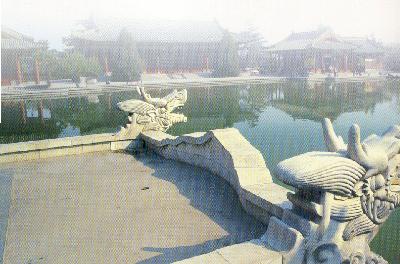Huaqing Hot Spring
Located to the north side of Lishan Mountain, the Huaqing Hot Spring is the bathing pool in Huaqing Palace built in the Tang Dynasty (618-907). It is famous for its hot springs and beautiful scenery.
 During the reign of King You of the Western Zhou Dynasty (11th century BC - 771BC), he built a resort here named Li Palace. Later, Qin Emperor Shihuang built a stone pool and named it "the Fairy′s Spring". The palace was expanded by Emperor Wudi of the Han Dynasty (206BC-220AD). During the Tang Dynasty, Emperor Xuanzong ordered a large-scale construction by transforming spring wells into pools housed in walled palaces. Since the palace was named the Huaqing Palace, the hot springs were named after it as the Huaqing Pool.
During the reign of King You of the Western Zhou Dynasty (11th century BC - 771BC), he built a resort here named Li Palace. Later, Qin Emperor Shihuang built a stone pool and named it "the Fairy′s Spring". The palace was expanded by Emperor Wudi of the Han Dynasty (206BC-220AD). During the Tang Dynasty, Emperor Xuanzong ordered a large-scale construction by transforming spring wells into pools housed in walled palaces. Since the palace was named the Huaqing Palace, the hot springs were named after it as the Huaqing Pool.
In the eastern area of the Huaqing Hot Spring, a tablet hangs in the room, and is inscribed with three golden Chinese characters Hua Qing Chi (the Huaqing Pool), written by Guo Moruo. In this area, there are the Lotus Pavilion, the Feixia Pavilion, the Five Chamber Hall, the Three Chamber Hall, and the Hovering Rainbow Bridge with a pavilion on each side. The Spring Eulogy engraved on the stone walls is among the elaborate works of stele art in the country.
The center area is a museum of imperial bathing pools built in the Tang Dynasty. In this area, there are the Lotus Flower Pool, the Chinese Flowering Crabapple Pool, the Crown Prince Pool, the Stars Pool, the showroom of cultural relics and the medicinal herbs used by the emperor during the bath. It is said that Emperor Xuanzong and his concucine Lady Yang both bathed here with medical herbs and that is said to be the reason why Emperor Xuanzong was able to lead a dissolute life in his seventies and his concubine Lady Yang gained his favor for such a long time.
In the western area, there are the Nine-Dragon Pool and the Feixia Hall. To the north of Feixia Hall, a big fresco, made up of 90 white marbles, is 9.15 meters high and 3.6 meters wide. The painting on the fresco is about Emperor Xuanzong′s first meeting with Lady Yang in Lishan Palace in the 28th year of his reign.
Source: http://www.chinaculture.org